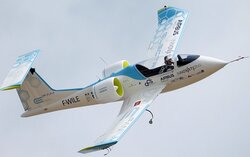Sure. Let's do the maths...
The existing 1 person quadcopter (e.g. the
Ehang 184) has a 15 kWh battery and a 23 minute air time. We could extrapolate that it would require 15*(60/20) = 45 kW in normal forward flight at 30 mph, or 45 kWh to carry one person 30 miles.
As you asserted, motor peak output is more than 2X this figure, 106 kW.
The existing model, of course doesn't have 30 mile range, it would only get 10 miles and then need to be charged for 2 hours, but I was supposing a future superior, lower specific mass battery.
A proper US SUV might have 15 mpg, and use 2 gallons of gasoline to carry one driver 30 miles in normal road traffic.
Primary energy content of 2 US gals of gasoline = 228,000 BTU. The Ehang's 45 kWh = 153,000 BTU.
It appears that the Ehang 184 electric helicopter uses less primary energy to move 1 person than some SUVs in current use, as asserted.
What am I missing?
------------------------------------------
While fixed wing aircraft can obviously glide, they don't always have a place to land in a dense urban area. The Ehang can neither glide nor even gyro, it would need a low-mass parachute in case of power failure. Multiple motors do provide some redundancy.
As for avoidance...three dimensions makes it easier rather than harder compared to two dimensions (or in a single lane, one dimension), especially with vehicles that can hover and execute sharp turns.





 .
.
 cruise power demand, but cruise energy consumption
cruise power demand, but cruise energy consumption 